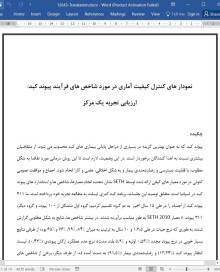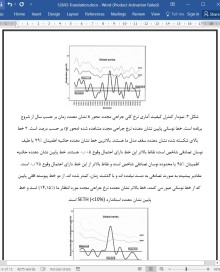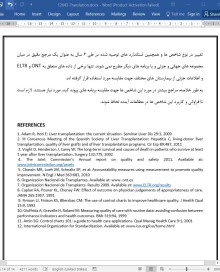
دانلود مقاله نمودار های کنترل کیفیت آماری در مورد شاخص های فرآیند پیوند کبد
چکیده
پیوند کبد که به عنوان بهترین گزینه در بسیاری از مراحل پایانی بیماری های کبد محسوب می شود، از متقاضیان بیشتری نسبت به اهدا کنندگان برخوردار است. در این وضعیت، لازم است تا این روش درمانی مورد تقاضا به شکل مطلوب، با قابلیت دسترسی و رضایتمندی بیمار و به شکل اخلاقی، علمی و کارا انجام شود. اجماع و موافقت عمومی کنونی در مورد معیار های کیفی ارائه شده توسط SETH نشان دهنده انجام معیارها، شاخص ها و استاندارد های پیوند کبد در اسپانیا است. مطابق توصیه این جلسات، برنامه کبد کنری ایسلند به مطالعه تجربه خود پرداخته است. ما 411 پیوند کبد از اجساد را در طی 15 سال اخیر به دو گروه تقسیم کردیم: گروه اول متشکل از 100 پیوند و گروه دیگر، 311 پیوند. 8 معیار SETH 2010 به طور مناسب برآورده شدند. در بیشتر شاخص ها، نتایج به شکل مطلوبی گزارش شدند به طوری که نرخ حیات در طی 1،3،5 و 10 سال به ترتیب به میزان %84، %79، %76 و %65 بود؛ از طرفی نتایج بسیار خوبی در نرخ پیوند مجدد (%0.56 اولیه و %5.9 بلند مدت)، نرخ عدم عملکرد ارگان پیوندی (%0.43)، لیست انتظار پیوند کبد (%13.34) و رضایتمندی بیمار (%91.5) به دست آمده اند. از طرف دیگر، برخی از شاخص های مرگ و میر همانند دوره پیش از عمل جراحی، پس از عمل جرایی و مرگ و میر اولیه با عملکرد معمولی گرافت و نرخ جراحی مجدد، نا مطلوب تر بوده اند. پس از تحلیل این سری ها با نمودار های کنترل کیفیت آماری، ما شاهد بهبود کلیه شاخص ها حتی در شاخص های نا مطلوب ظاهری، مرگ و میر زودهنگام با عملکرد نرمال گرافت در یک برنامه پایدار بوده ایم. این نتایج به ما در تشخیص حوزه های خاص جهت بهبود برنامه کمک می کنند. کاربرد اندازه گیری کیفیت مطابق توصیه SETH، در تحقیق ما نشان میدهد که علیرغم زمان بر بودن این فرآیند، این روش به عنوان یک ابزار مفید محسوب می شود.
پیوند کبد به عنوان یک گزینه مطلوب جهت درمان بیماری مرحله نهایی عضو محسوب می شود. با توجه به تعداد بسیار کم اهدا کنندگان و افزایش طیفی از شاخص های پیوند، این روش درمان مورد توجه باید به صورت مناسب از نظر اخلاقی، علمی و مالی انجام شود. جهت ارزیابی دقیق برنامه پیوند کبد، برخی از مؤسسات و سازمان های علمی به تحلیل این فرآیند با استفاده از معیار های کیفی پرداخته و پایش جهت دستیابی به کارایی، قابلیت دسترسی و رضایتمندی بیمار را پیشنهاد کرده اند.
بحث
پیوند موفقیت آمیز کبد بستگی به روند ها؛ ارزیابی داوطلب، مهارت ها و تخصص در فرآیند جراحی و پایش پیوسته در بیمارستان و به صورت بلند مدت، دارد. این الگوی فرآیند پیچیده تحت تأثیر عملکرد چند حوزه ای متخصصان مختلف پزشکی، پرستاران و کارشناسان دیگر دارد. این جنبه ها موجب ایجاد پیامد های اقتصادی و پزشکی برای مراقبت از بیمار، جامعه و تخصص پزشکی می شوند. در واقع، پیوند کبد به عنوان گزینه درمانی برای مراحل نهایی بیماری هپاتیت بر اساس ارزیابی دقیق کارایی و اعتبار آن، محسوب می شود. در حال حاضر، کمبود جدی در تعداد اهدا کنندگان موجب ایجاد یک وضعیت پیچیده همراه با مسائل اخلاقی جهت اهدای عضو شده است. در این چارچوب، لازم است تا بهترین نتایج توسط هر برنامه پیوند کبد، تضمین شود.
جهت کمک به جامعه پیوند جهت برطرف کردن این چالش، برخی از نهاد ها در اسپانیا در تلاش برای طراحی روش های اندازه گیری هستند که پیشرفت در فرآیند مراقبت مبتنی بر شواهد را به دقت ثبت می کنند. از سال 2002 در استرالیا برای اولین بار و از سال 2005 تا کنون، SETH چندین جنبه از کیفیت مراقبت در پیوند کبد را پیشنهاد کرده است. این فرآیند به صورت موفقیت آمیز در مناطق دیگر مورد استفاده قرار گرفته است.
آخرین سند اصلاحی SETH عرضه شده در سال 2010 که اخیراً منتشر شده است، لزوم کیفیت کنترل کیفیت با تعریف جنبه های مختلف مانند معیار ها، شاخص ها و استاندارد ها را جهت ارزیابی و پایش برنامه های پیوند کبد افراد فوت شده در اسپانیا به شکل واضح نشان میدهد. هدف ما در این تحقیق، بررسی برنامه پیوند کبد ما بوده است که از ماه آوریل سال 1996 در یک مرکز نسبتاً کوچک با یک دوره زمانی طولانی جهت دستیابی به 100 پیوند کبد اول ( از آوریل 1994 تا می 2001) و با وضعیت ژئوگرافیکی دشوار که به دور از سرزمین اصلی انجام شده و شامل هفت جزیره است، صورت گرفته است.
Abstract
Liver transplantation, the best option for many end-stage liver diseases, is indicated in more candidates than the donor availability. In this situation, this demanding treatment must achieve excellence, accessibility and patient satisfaction to be ethical, scientific, and efficient. The current consensus of quality measurements promoted by the Sociedad Española de Trasplante Hepático (SETH) seeks to depict criteria, indicators, and standards for liver transplantation in Spain. According to this recommendation, the Canary Islands liver program has studied its experience. We separated the 411 cadaveric transplants performed in the last 15 years into 2 groups: The first 100 and the other 311. The 8 criteria of SETH 2010 were correctly fulfilled. In most indicators, the outcomes were favorable, with an actuarial survivals at 1, 3, 5, and 10 years of 84%, 79%, 76%, and 65%, respectively; excellent results in retransplant rates (early 0.56% and long-term 5.9%), primary nonfunction rate (0.43%), waiting list mortality (13.34%), and patient satisfaction (91.5%). On the other hand, some indicators of mortality were worse as perioperative, postoperative, and early mortality with normal graft function and reoperation rate. After the analyses of the series with statistical quality control charts, we observed an improvement in all indicators, even in the apparently worst, early mortality with normal graft functions in a stable program. Such results helped us to discover specific areas to improve the program. The application of the quality measurement, as SETH consensus recommends, has shown in our study that despite being a consuming time process, it is a useful tool.
LIVER transplantation is the preferred option for treating an end-stage organ failure. In the framework of scarce donors and an increasing breath of indications for transplantations, this demanding treatment must be appropriate in ethical, scientific, and financial terms.1 To accurately assess a liver transplant program, some institutions and scientific organizations have analyzed the process using quality criteria, proposing monitoring to achieve excellence, accessibility, and patient satisfaction.
DISCUSSION
Successful liver transplantation depends on many procedures; candidate evaluation, skill and expertise in the surgical procedure, and ongoing monitoring both in hospital and long term. This paradigm of a complex process is characterized by the multidisciplinary work of various medical specialities, nurses, and other professionals. The aspects produce economic and clinical consequences for in-patient care, society, and medical expertise. Yet, liver transplantation is the treatment of choice for end-stage hepatic disease based upon thorough demonstration of its validity.1,3 Currently, the serious donor scarcity has evolved into a difficult situation with ethical implications for organ allocation.1 It is mandatory in this frame to guarantee the best outcomes by each program of liver transplantation.
To help the transplant community must this challenge, some institutions in Spain are trying to design measurements that accurately capture improvements in evidencebased care processes. Since 2002 in Andalusia first and from 2005 to present, the SETH has recommended several aspects of the quality of care in liver transplantation.2 This process has been employed successfully in other areas.4,5
The last revised document of the SETH promulgated in 2010 and published recently2 highlighted the necessity of quality of care control defining controversial aspects such as criteria, indicators and standards to evaluate and monitor Spanish programs of cadaveric liver transplants in a transparent fashion. Our purpose in this study was to monitor our own liver transplant program, which has been active since April 1996 in a low-volume center with a lengthy period to achieve the first 100 liver transplantation (from April 1994 to May 2001) and with a challenging geographical situation that is far away from the mainland and includes seven islands.
چکیده
روش ها
نرمالیزه کردن و ارائه گواهی برنامه ISO 9001:2008
جمع آوری داده
پردازش داده
نتایج
بحث
منابع
ABSTRACT
METHODS
Normalization and Certification of the Program by ISO 9001:2008
Data Collection
Data Processing
RESULTS
DISCUSSION
REFERENCES



